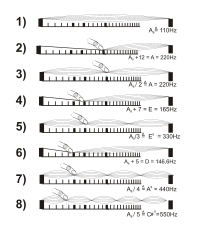
Artificial harmonic
Encyclopedia
To produce an artificial harmonic, a stringed instrument player holds down a note on the neck with the non-dominant hand
, thereby shortening the vibrational length of the string, uses a finger to lightly touch a point on the string that is an integer divisor of its vibrational length, and plucks or bow
s the side of the string that is closer to the bridge. This technique is used to produce harmonic tones that are otherwise inaccessible on the instrument. To guitar players, one variety of this technique is known as a pinch harmonic
.
This technique, like natural harmonics, works by canceling out the fundamental tone and one or more partial tones by deadening their modes of vibration. See node
.

When a string
is plucked or bowed, the string vibrates
at several frequencies
. The vibration along the entire length of the string is known as the fundamental
, while vibrations occurring between points along the string (known as nodes
) are referred to as overtone
s. The fundamental and overtones, when sounded together, are perceived by the listener as a single tone, though the relative prominence of the frequencies varies among instruments, and contribute to its timbre
.
s are produced on the instrument by lightly touching a string (as opposed to fretting it) at any of several points along its length. The fundamental tone will not vibrate; specific overtones, however, will, resulting in a chimelike tone. Harmonics produced by this method based on open-string fundamentals are termed "natural." If the string is fretted, the harmonics are termed "artificial." Natural harmonics may only be sounded at the strings' nodes
. The nodes for natural harmonics fall at the following points along the guitar's neck:
Handedness
Handedness is a human attribute defined by unequal distribution of fine motor skills between the left and right hands. An individual who is more dexterous with the right hand is called right-handed and one who is more skilled with the left is said to be left-handed...
, thereby shortening the vibrational length of the string, uses a finger to lightly touch a point on the string that is an integer divisor of its vibrational length, and plucks or bow
Bow (music)
In music, a bow is moved across some part of a musical instrument, causing vibration which the instrument emits as sound. The vast majority of bows are used with string instruments, although some bows are used with musical saws and other bowed idiophones....
s the side of the string that is closer to the bridge. This technique is used to produce harmonic tones that are otherwise inaccessible on the instrument. To guitar players, one variety of this technique is known as a pinch harmonic
Pinch harmonic
A pinch harmonic or pick harmonic is a guitar technique in which the player's thumb or index finger on the picking hand slightly catches the string after it is picked, canceling the fundamental of the string, and letting one of the overtones dominate. This results in a high pitched sound...
.
This technique, like natural harmonics, works by canceling out the fundamental tone and one or more partial tones by deadening their modes of vibration. See node
Node (physics)
A node is a point along a standing wave where the wave has minimal amplitude. For instance, in a vibrating guitar string, the ends of the string are nodes. By changing the position of the end node through frets, the guitarist changes the effective length of the vibrating string and thereby the...
.
Overtones

When a string
Strings (music)
A string is the vibrating element that produces sound in string instruments, such as the guitar, harp, piano, and members of the violin family. Strings are lengths of a flexible material kept under tension so that they may vibrate freely, but controllably. Strings may be "plain"...
is plucked or bowed, the string vibrates
Vibration
Vibration refers to mechanical oscillations about an equilibrium point. The oscillations may be periodic such as the motion of a pendulum or random such as the movement of a tire on a gravel road.Vibration is occasionally "desirable"...
at several frequencies
Frequency
Frequency is the number of occurrences of a repeating event per unit time. It is also referred to as temporal frequency.The period is the duration of one cycle in a repeating event, so the period is the reciprocal of the frequency...
. The vibration along the entire length of the string is known as the fundamental
Fundamental
Fundamental may refer to:* Foundation of reality* Fundamental frequency, as in music or phonetics, often referred to as simply a "fundamental"...
, while vibrations occurring between points along the string (known as nodes
Node (physics)
A node is a point along a standing wave where the wave has minimal amplitude. For instance, in a vibrating guitar string, the ends of the string are nodes. By changing the position of the end node through frets, the guitarist changes the effective length of the vibrating string and thereby the...
) are referred to as overtone
Overtone
An overtone is any frequency higher than the fundamental frequency of a sound. The fundamental and the overtones together are called partials. Harmonics are partials whose frequencies are whole number multiples of the fundamental These overlapping terms are variously used when discussing the...
s. The fundamental and overtones, when sounded together, are perceived by the listener as a single tone, though the relative prominence of the frequencies varies among instruments, and contribute to its timbre
Timbre
In music, timbre is the quality of a musical note or sound or tone that distinguishes different types of sound production, such as voices and musical instruments, such as string instruments, wind instruments, and percussion instruments. The physical characteristics of sound that determine the...
.
Harmonics
HarmonicHarmonic
A harmonic of a wave is a component frequency of the signal that is an integer multiple of the fundamental frequency, i.e. if the fundamental frequency is f, the harmonics have frequencies 2f, 3f, 4f, . . . etc. The harmonics have the property that they are all periodic at the fundamental...
s are produced on the instrument by lightly touching a string (as opposed to fretting it) at any of several points along its length. The fundamental tone will not vibrate; specific overtones, however, will, resulting in a chimelike tone. Harmonics produced by this method based on open-string fundamentals are termed "natural." If the string is fretted, the harmonics are termed "artificial." Natural harmonics may only be sounded at the strings' nodes
Node (physics)
A node is a point along a standing wave where the wave has minimal amplitude. For instance, in a vibrating guitar string, the ends of the string are nodes. By changing the position of the end node through frets, the guitarist changes the effective length of the vibrating string and thereby the...
. The nodes for natural harmonics fall at the following points along the guitar's neck:
| Fret | Note | |
|---|---|---|
| 1/2 | 12 | octave tonic |
| 1/3 | 7, 19 | octave + fifth |
| 1/4 | 5, 24 | 2nd octave |
| 1/5 | 4 (3.9), 9, 16 | 2nd octave + third |
| 1/6 | 3.2 | 2nd octave + fifth |
| 1/7 | 2.7 | 2nd octave + minor seventh |
| 1/8 | 2.3 | 3rd octave |
| 1/9 | 2 | 3rd octave + second |
| 1/10 | 1.8 | 3rd octave + third |
See also
- 3rd Bridge3rd BridgeThe 3rd bridge is an extended playing technique used on some string instruments , that allows a musician to produce distinctive timbres and overtones that are unavailable on a conventional string instrument with two bridges...
- HarmonicHarmonicA harmonic of a wave is a component frequency of the signal that is an integer multiple of the fundamental frequency, i.e. if the fundamental frequency is f, the harmonics have frequencies 2f, 3f, 4f, . . . etc. The harmonics have the property that they are all periodic at the fundamental...
- Pinch harmonicPinch harmonicA pinch harmonic or pick harmonic is a guitar technique in which the player's thumb or index finger on the picking hand slightly catches the string after it is picked, canceling the fundamental of the string, and letting one of the overtones dominate. This results in a high pitched sound...

